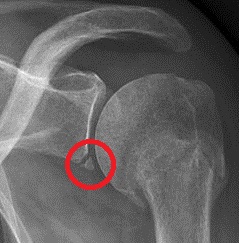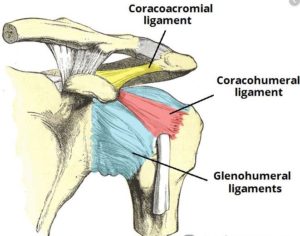Shoulder pain can arise from many injuries including dislocation and subluxation. For patients with Ehler-Danlos Syndrome (EDS), this is especially problematic given their joint laxity. EDS is a group of inherited disorders that affect and weaken connective tissues such as tendons and ligaments (1). And EDS shoulder pain is often characterized by joints that are typically hypermobile with an excessive range of motion.
What is Hypermobility?
Hypermobility means that the joint is too mobile or too lax, and it is a major culprit in shoulder pain when it comes to EDS.
Ligaments and muscles stabilize joints and keep them moving in set predetermined motions with micro-millimeter precision. When the ligaments are loose. the joint surfaces crash together abnormally, causing more wear and tear on the joint itself, damaging cartilage, tendons, and other structures. This is also called instability.
What is the Difference Between Subluxation and Dislocation?
A dislocation is when there is a displacement of a bone from its natural position in the joint. Dislocations can occur due to trauma such as a fall or if the supporting ligaments in the shoulder are injured, torn, or separated. Dislocation is also referred to as luxation. A subluxation is simply a partial dislocation. Subluxations can occur as a result of trauma, injury to supporting ligaments and tendons, or lax ligaments. Patients with EDS (EDS-HT) have known impaired shoulder function (2) which along with ligament laxity puts them at risk for dislocation or subluxation. This includes children with EDS.
What Happens if a Dislocated Shoulder Goes Untreated?
Shoulder dislocation is serious and if left untreated can result in the following:
- Damage to the muscles and tendons
- Damage to rotator cuff tendons;
- Nerve or blood vessel damage
- Damage to the humeral head which is referred to as a Hill-Sachs lesion (3). When the humerus displaces anteriorly it causes a depression in the back and outside of the shoulder bone (humerus).
- Damage to the labrum which is referred to as a Bankart lesion (4). When the humerus displaces towards the front it can also injure the fibrocartilage cup that helps to hold it in place called the labrum.
- Damage to the ligaments that stabilize the top of the shoulder (glenohumeral ligaments and coracohumeral ligaments) (5).
How Do You Fix a Dislocated Shoulder?
If dislocated it is critical that you seek immediate medical attention and get the joint back to its normal position( 6). This may include a forceful maneuver termed closed reduction of the joint. Once the joint is back and properly aligned, working in physical therapy to strengthen the rotator cuff muscles may help prevent future dislocations. This is because they help hold the ball in the socket. In extreme cases, you may be placed in a brace for a few weeks to help the damaged ligaments heal, but this is less common.
What to Make Sure You Rule Out
If your shoulder dislocates, as discussed above you could have injured lots of different structures including tendons, the labrum, the bones, etc… Hence an MRI is critical to make sure nothing got damaged. If something was harmed, then while sometimes surgery is needed, most of the time a precise injection of your own concentrated blood platelets or stem cells may help heal the damage.
Can Injections Help the Dislocations?
Steroid injections are not indicated in patients with shoulder dislocation as the steroid can compromise both the cartilage in the joint and the supporting ligaments. (7). At the Centeno-Schultz Clinic, we have extensive experience with precise ultrasound-guided injections of both PRP and stem cells into shoulder ligaments. Studies have demonstrated the beneficial effects of PRP on ligament and tendon injuries. (8). The goal is to tighten down the lax ligaments to prevent future dislocations and in our experience, this helps EDS patients live a more normal life.
As you can see, there is hope for EDS patients with chronic shoulder subluxations or dislocations. However, recognizing what’s going on and why is critical. Also making sure nothing was damaged is important. Finally, we’ve seen that newer orthobiologic injection therapies for the shoulder, or any other joint in the body for that matter, can help EDS patients live a more normal life!
Doctors that Can Help Treat EDS Shoulder Pain

Christopher J. Centeno, MD
Christopher J. Centeno, M.D. is an international expert and specialist in Interventional Orthopedics and the clinical use of bone marrow concentrate in orthopedics.
Dr. Centeno is one of the few physicians in the world with extensive experience in the culture expansion of and clinical use of adult bone marrow concentrate to treat orthopedic injuries. His clinic incorporates a variety of revolutionary pain management techniques to bring its broad patient base relief and results. Dr. Centeno treats patients from all over the US who travel to Colorado to undergo innovative, non-surgical treatments. Dr. Centeno has chaired multiple international research-based conferences. He also maintains an active research-based practice, with multiple publications listed in the US National Library of Medicine. Dr. Centeno has also served as editor-in-chief of a medical research journal dedicated to traumatic injury.
Dr. Centeno trained at the Baylor College of Medicine, Texas Medical Center, and the Institute for Rehabilitation Research. He hails from both Florida and New York and currently resides in Boulder, Colorado with his wife and three children.

John Schultz, MD
John R. Schultz M.D. is a national expert and specialist in Interventional Orthopedics and the clinical use of bone marrow concentrate for orthopedic injuries. He is board certified in Anesthesiology and Pain Medicine and underwent fellowship training in both. Dr. Schultz has extensive experience with same day as well as culture expanded bone marrow concentrate and sees patients at the CSC Broomfield, Colorado Clinic, as well the Regenexx Clinic in Grand Cayman. Dr. Schultz emphasis is on the evaluation and treatment of thoracic and cervical disc, facet, nerve, and ligament injuries including the non-surgical treatment of Craniocervical instability (CCI). Dr. Schultz trained at George Washington School of…
Read more
John Pitts, M.D.
Dr. Pitts is originally from Chicago, IL but is a medical graduate of Vanderbilt School of Medicine in Nashville, TN. After Vanderbilt, he completed a residency in Physical Medicine and Rehabilitation (PM&R) at Emory University in Atlanta, GA. The focus of PM&R is the restoration of function and quality of life. In residency, he gained much experience in musculoskeletal medicine, rehabilitation, spine, and sports medicine along with some regenerative medicine. He also gained significant experience in fluoroscopically guided spinal procedures and peripheral injections. However, Dr. Pitts wanted to broaden his skills and treatment options beyond the current typical standards of care.
Read more
Jason Markle, D.O.
Post-residency, Dr. Markle was selected to the Interventional Orthopedic Fellowship program at the Centeno-Schultz Clinic. During his fellowship, he gained significant experience in the new field of Interventional Orthopedics and regenerative medicine, honing his skills in advanced injection techniques into the spine and joints treating patients with autologous, bone marrow concentrate and platelet solutions. Dr. Markle then accepted a full-time attending physician position at the Centeno-Schultz Clinic, where he both treats patients and trains Interventional Orthopedics fellows. Dr. Markle is an active member of the Interventional Orthopedic Foundation and serves as a course instructor, where he trains physicians from around the world.
Read more
Brandon T. Money, D.O., M.S.
Dr. Money is an Indiana native who now proudly calls Colorado home. He attended medical school at Kansas City University and then returned to Indiana to complete a Physical Medicine and Rehabilitation residency program at Indiana University, where he was trained on non-surgical methods to improve health and function as well as rehabilitative care following trauma, stroke, spinal cord injury, brain injury, etc. Dr. Money has been following the ideology behind Centeno-Schultz Clinic and Regenexx since he was in medical school, as he believed there had to be a better way to care for patients than the status quo. The human body has incredible healing capabilities…
Read more————————————————————————-
References:
1. Zhou Z, Rewari A, Shanthanna H. Management of chronic pain in Ehlers-Danlos syndrome- EDS shoulder pain: Two case reports and a review of literature. Medicine (Baltimore). 2018;97(45):e13115. doi:10.1097/MD.0000000000013115
2. Johannessen EC, Reiten HS, Løvaas H, Maeland S, Juul-Kristensen B. Shoulder function, pain and health related quality of life in adults with joint hypermobility syndrome/Ehlers-Danlos syndrome-hypermobility type. Disabil Rehabil.2016;38(14):1382-90.DOI: 10.3109/09638288.2015.1102336
3. Horst K, Von Harten R, Weber C, et al. Assessment of coincidence and defect sizes in Bankart and Hill-Sachs lesions after anterior shoulder dislocation: a radiological study. Br J Radiol. 2014;87(1034):20130673.doi: 10.1259/bjr.20130673
4. Spiegl UJ, Ryf C, Hepp P, Rillmann P. Evaluation of a treatment algorithm for acute traumatic osseous Bankart lesions resulting from first time dislocation of the shoulder with a two year follow-up. BMC Musculoskelet Disord. 2013;14:305. doi: 10.1186/1471-2474-14-305.
5. Burkart AC, Debski RE. Anatomy and function of the glenohumeral ligaments in anterior shoulder instability. Clin Orthop Relat Res. 2002 Jul;(400):32-9. DOI: 10.1097/00003086-200207000-00005
6. Avila Lafuente JL, Moros Marco S, García Pequerul JM. Controversies in the Management of the First Time Shoulder Dislocation. Open Orthop J. 2017;11:1001-10.DOI: 10.2174/1874325001711011001
7.Laseter JT, Russell JA. Anabolic steroid-induced tendon pathology: a review of the literature. Med Sci Sports Exerc.1991;23(1):1-3. https://www.ncbi.nlm.nih.gov/pubmed/1997802
8. Kia C, Baldino J, Bell R, Ramji A, Uyeki C, Mazzocca A. Platelet-Rich Plasma: Review of Current Literature on its Use for Tendon and Ligament Pathology. Curr Rev Musculoskelet Med. 2018;11(4):566-72. DOI: 10.1007/s12178-018-9515-y



